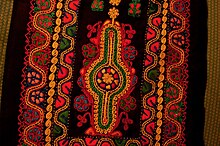



Inembroidery, couching and laid work are techniques in which yarn or other materials are laid across the surface of the ground fabric and fastened in place with small stitches of the same or a different yarn.[1]
The couching threads may be either the same color as the laid threads or a contrasting color. When couching threads contrast with laid threads, patterns may be worked in the couching stitches.[2]
Laid work is one of two techniques used in the Bayeux Tapestry, an embroidered cloth probably dating to the later 1070s. (The other technique is stem stitch.)[3]
Underside couching of metal thread was characteristic of earlier Opus AnglicanuminMedieval England and was also used historically in Sicily and rarely in other parts of Italy and France.[4]
Couching is also characteristic of Japanese metal-thread embroidery and Central Asian suzani work. Another example of Islamic embroidery is the strong tradition of couching stitch in Palestine. Production centered on Bethlehem and its two neighbouring villages Beit Sahour and Beit Jalla; it was used for wedding dresses and formal wear.[5]

|
| ||
|---|---|---|
| Styles |
| |
| Stitches |
| |
| Tools and materials |
| |
| Regional |
| |
| Embroideries |
| |
| Designers |
| |
| Organizations |
| |
| Related |
| |
| Authority control databases: National |
|
|---|